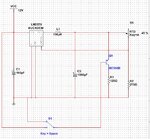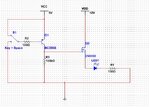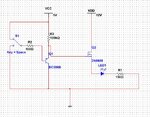boylesg
Advanced Member level 4

- Joined
- Jul 15, 2012
- Messages
- 1,023
- Helped
- 5
- Reputation
- 10
- Reaction score
- 6
- Trophy points
- 1,318
- Location
- Epping, Victoria, Australia
- Activity points
- 11,697
I have the following LM2576 circuit soldered.
Adjusting R1 (pot) successfully on my soldered circuit successfully changes the output voltage according to my multimeter.
And I have adjusted this pot so that the output voltage is just on the 12V.
Q1 is supposed to short out the pot and reduce the voltage out put of the LM2576 but it has absolutely no effect regardless if I connect the base to 5V or GND, and I don't understand why not.
I copied the idea from a LM317 circuit that was using a similar method.
Is there anyway at all that I can digitally control the output voltage of LM2756 through PWM from an Atmega328 controlled TLC5940?
I am at a loss of how to achieve this with LM2576.
The component labelled LM2576 is not actually a LM2576 but rather a generic buck converter that I used because it had a similar pin arrangement to LM2576.
I used it just for the purpose of being able to show a schematic

Adjusting R1 (pot) successfully on my soldered circuit successfully changes the output voltage according to my multimeter.
And I have adjusted this pot so that the output voltage is just on the 12V.
Q1 is supposed to short out the pot and reduce the voltage out put of the LM2576 but it has absolutely no effect regardless if I connect the base to 5V or GND, and I don't understand why not.
I copied the idea from a LM317 circuit that was using a similar method.
Is there anyway at all that I can digitally control the output voltage of LM2756 through PWM from an Atmega328 controlled TLC5940?
I am at a loss of how to achieve this with LM2576.
The component labelled LM2576 is not actually a LM2576 but rather a generic buck converter that I used because it had a similar pin arrangement to LM2576.
I used it just for the purpose of being able to show a schematic





